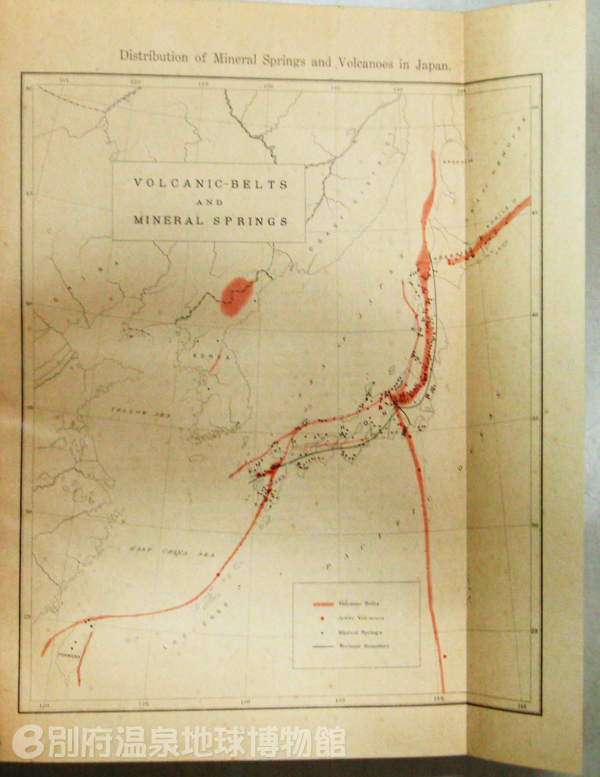Geological and geographical studies of hot spring areas from mid-Meiji to Taisho Era
After the publication of The Mineral Springs of Japan in 1886, Home Ministry continued to conduct analyses on mineral springs in Japan. The results of these studies were published from time to time. In 1915, the German and English versions of The Mineral Springs of Japan were exhibited at international expositions held in Dresden (Germany) and St. Louis (United States), and were introduced to many countries around the world.
The version of The Mineral Springs of Japan presented at the Panama-Pacific International Exposition in St. Louis contained numerous analytical charts, introduced hot spring areas, and presented a distribution map of mineral springs in Japan. The figure below is a copy of the image. Although the image is old and yellowish, it provides an overview of the content.
Pay attention to the red linings that indicate the volcanic belt in this figure. During this period, detailed geological and geographical studies were conducted on the island clusters that form an arc2, the Kuril Islands, the Japanese Islands and the Nansei Islands, and on the coastal regions of mainland Japan. The close relationship between volcanoes and hot springs was already recognized by modern science. Overall, the volcanic belt depicted in the figure can still be applied to today's volcanic front
At the time, the results of the geoscience research related to volcanoes and hot springs were published in Journal of Geography, The Journal of the Geological Society of Japan and Reports, Geological Survey of Japan3. Presumably, the attached figure is a summary of the aforementioned research.
During that period, the Department of Geology was established in 1921 within the College of Science at the Kyoto Imperial University (currently Kyoto University), starting a new chapter in the development of geological studies. The specifics of the development were published in the Japanese Earth magazine, a monthly magazine with its first issue published in 1924. The second issue published featured hot springs and included the details and characteristics of the distribution of hot springs in Japan. After the publication of that issue, certain facts became common knowledge, such as that hot springs are found mainly on low ground. Besides that, the corresponding relationship between the distribution of hot springs and the tectonic lines was also described in detail. These have all become the basis for hot spring research in the later ages.
|

Figure: Ishizu (1915). The Distribution of Mineral Springs and Volcanoes in Japan.
Black dots: Mineral springs; Red dots: Active volcanoes;
Red lines: Volcanic belt; Black lines: Tectonic lines of the Tertiary Period1
|
1 The Tertiary Period
The Tertiary Period belongs to one of the geological periods, about 66 million to 2.6 million years ago. Succeeded by the Quaternary Period, which is the current period.
2 Islands shaped in an arc
These islands are called "the arc islands". Situated on the subduction zone of the tectonic plates. Recently, they have become commonly known as "island-arc".
The Kuril islands, the Japanese islands and the Nansei (Southwestern) islands are some of the most famous island arcs in the world. The islands are also known as "festoon-islands," as the islands are situated in an arc shape that resembles a festoon.
3 Journals
Journal of Geography: Organ of Tokyo Geographical Society (established in 1879), Geographical.
The Journal of the Geological Society of Japan: Organ of The Geological Society of Japan (established in 1893), Geological.
Reports, Geological Survey of Japan: One of the organs of Geological Survey of Japan (established in 1882), Geological.
The Geological Survey of Japan was reorganized and incorporated into the National Institute of Advanced Industrial Science and Technology (AIST).

Risaku Ishizu (1915). The Mineral Springs of Japan for the Panama-Pacific International Exposition.
Takaharu Fukutomi (1936). The Physics of Hot Springs. Iwanami Shoten.
Yasuzo Hattori (1959). The Guideline of Hot Springs. Hirokawa Publishing Inc.
↑TOP